Juniper JN0-682 Exam Questions
Questions for the JN0-682 were updated on : Jun 24 ,2025
Page 1 out of 5. Viewing questions 1-15 out of 65
Question 1
What is an advantage that EVPN has over VPLS when used for DC I?
- A. mass MAC withdrawal
- B. transparent BPDU transport
- C. active/standby multihoming
- D. reverse path forwarding
Answer:
A
Question 2
Exhibit.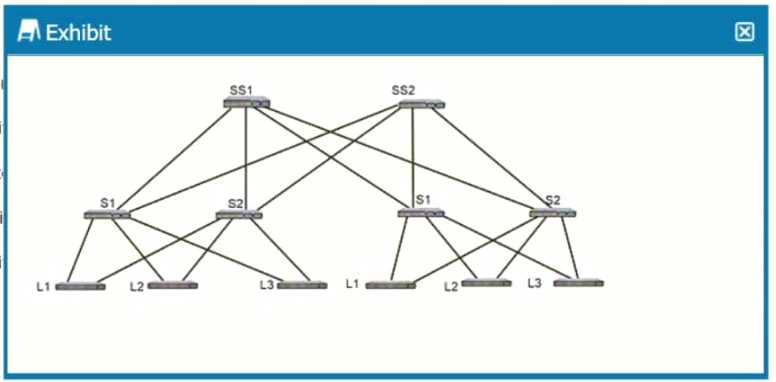
Referring to the exhibit, which statement is correct?
- A. The exhibit shows a 5-stage IP fabric architecture.
- B. The exhibit shows a collapsed fabric architecture.
- C. The exhibit does not represent a valid fabric architecture.
- D. The exhibit shows a 3-stage IP fabric architecture.
Answer:
A
Question 3
Exhibit.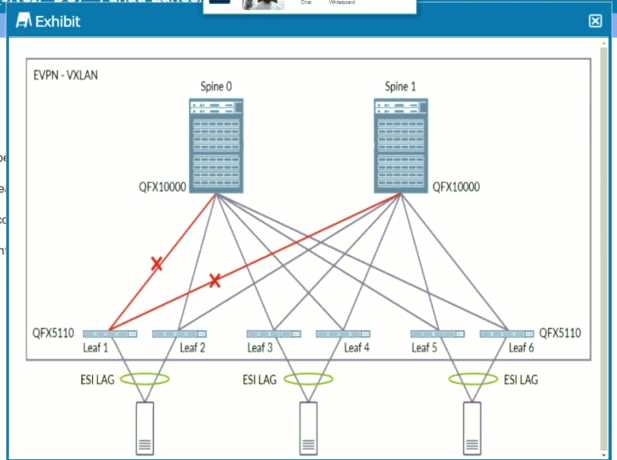
Referring to the exhibit, what effect does EVPN core isolation have?
- A. Leaf 1 will send a pause frame to each connected host.
- B. Leaf 1 will place the interfaces to connected hosts into LACP passive mode.
- C. Leaf 1 will take down all revenue interfaces.
- D. Spine 1 will block all traffic.
Answer:
C
Question 4
Exhibit.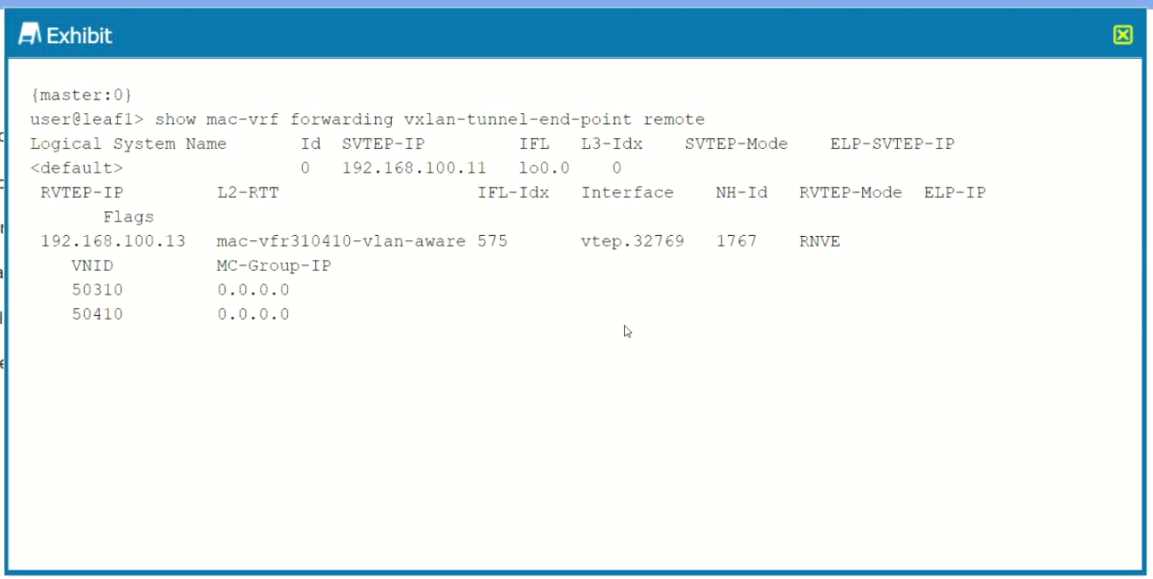
Referring to the exhibit, which two statements are correct? (Choose two.)
- A. There are two tunnels to the remote endpoint.
- B. The irb. 0 interface is the remote tunnel endpoint interface.
- C. The source tunnel IP address is 192.168.100.11.
- D. There is one tunnel to the remote endpoint.
Answer:
CD
Question 5
You are asked to deploy an Ethernet bridging design in a data center with the following criteria:
--routing must occur on the leaf devices.
--VTEPs must terminate on the leaf devices.
--facilitate inter-VLAN communication, -- lower latency with East-West traffic.
Which architecture should you use in this scenario?
- A. collapsed spine architecture
- B. edge-routed bridging architecture
- C. bridge overlay architecture
- D. centrally-routed bridging architecture
Answer:
B
Question 6
You are asked to enable visibility into your EVPN-VXLAN network traffic by monitoring traffic
continuously. Which two statements are correct in this scenario? (Choose two.)
- A. You cannot enable sFlow monitoring on each interface individually.
- B. The sFlow agent is installed by default on your OFX Series switch.
- C. You must enable sFlow monitoring on each interface individually.
- D. The sFlow agent needs to be manually installed on your QFX Series switch.
Answer:
BC
Question 7
Exhibit.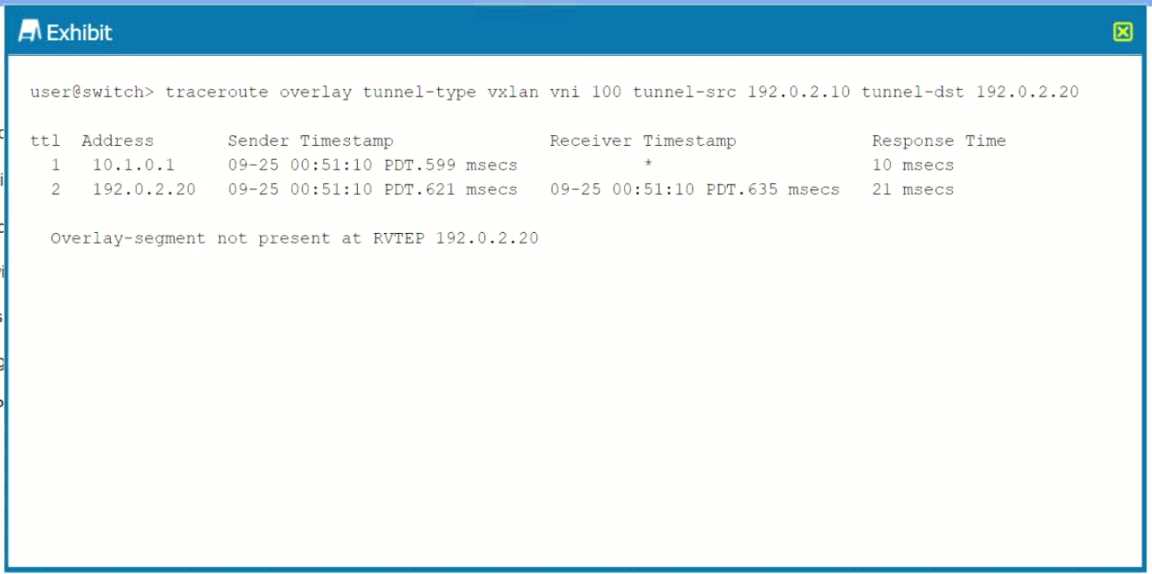
You are troubleshooting a problem with traffic not reaching a remote VTEP
Referring to the exhibit, what is the reason for the problem?
- A. A conflict exists with the VLAN-to-VNI mapping.
- B. The local VTEP is misconfigured with the wrong VNI.
- C. No VTEP is configured on peer 192.0.2.20.
- D. The remote VTEP does not have the correct VNI configured.
Answer:
D
Question 8
Exhibit.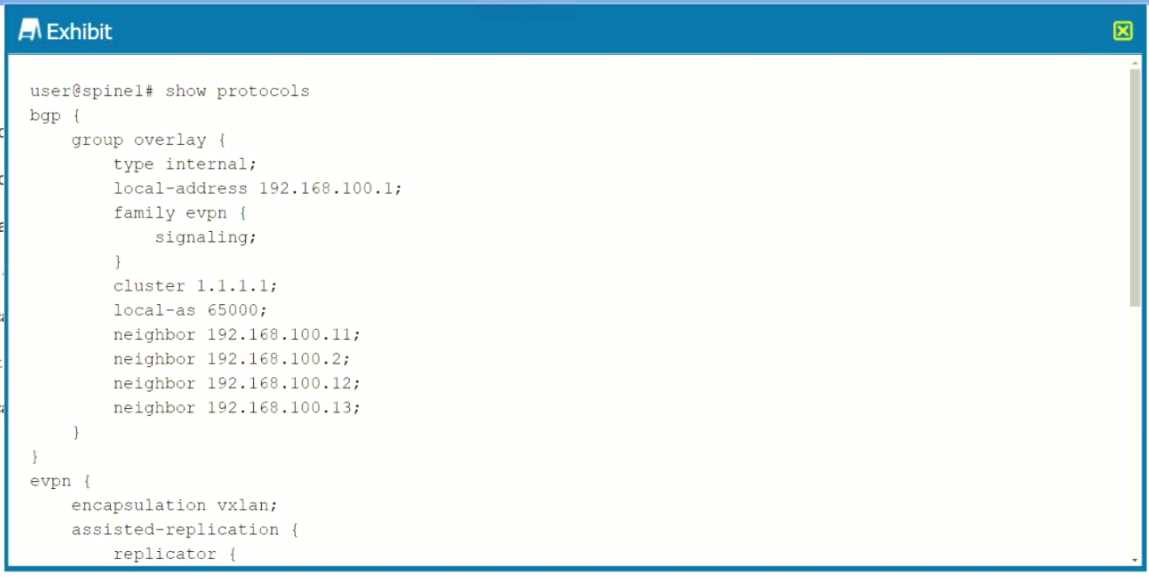
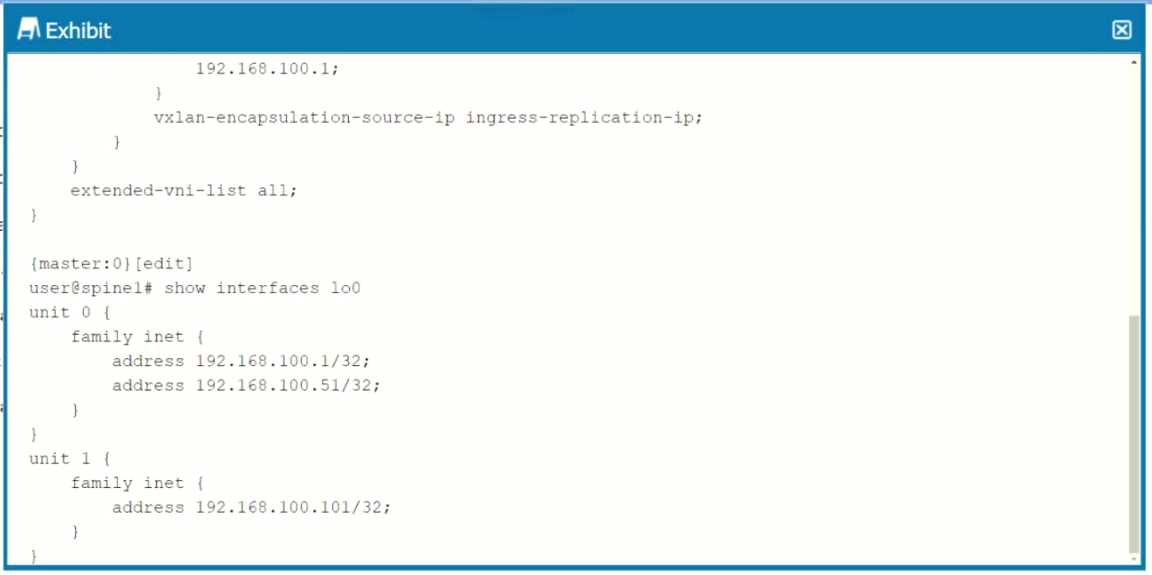
The configuration shown in the exhibit is intended to set up assisted replication but will not commit.
Which action will create a valid configuration in this situation?
- A. Change the 10.0 address to 192.168.100.1 primary.
- B. Change the replicator inet address to 192.168.100.101.
- C. Delete replicator inet 192.168.100.1.
- D. Change the replicator inet address to 192.168.100. 51.
Answer:
B
Question 9
You are asked to implement VXLAN in your data center network. You must choose between
implementing EVPN signaling and multicast signaling. Which two statements are correct in this
scenario? (Choose two.)
- A. EVPN signaling reduces ARP flooding and multicast signaling does not.
- B. EVPN signaling propagates MAC addresses across the network and multicast signaling does not.
- C. EVPN signaling uses a standards-based protocol and multicast signaling does not.
- D. EVPN signaling enables distributed Layer 3 gateways and multicast signaling does not.
Answer:
BC
Question 10
You have a two spine and four leaf CRB topology and you must ensure that the hosts connected to
the leaf devices have reachability to all IRB interface addresses, including the local spine IRB
addresses, and the virtual gateway address.
Which two configuration parameters must be used to accomplish this task? (Choose two.)
- A. Configure a spine-to-spine BGP peering as part of the overlay.
- B. Configure virtual-gateway-accept-data under the IRB interface.
- C. Configure a spine-to-spine EVPN peering as part of the routing instance.
- D. Configure proxy-macip-advertisement under the IRB interface.
Answer:
BD
Question 11
Exhibit.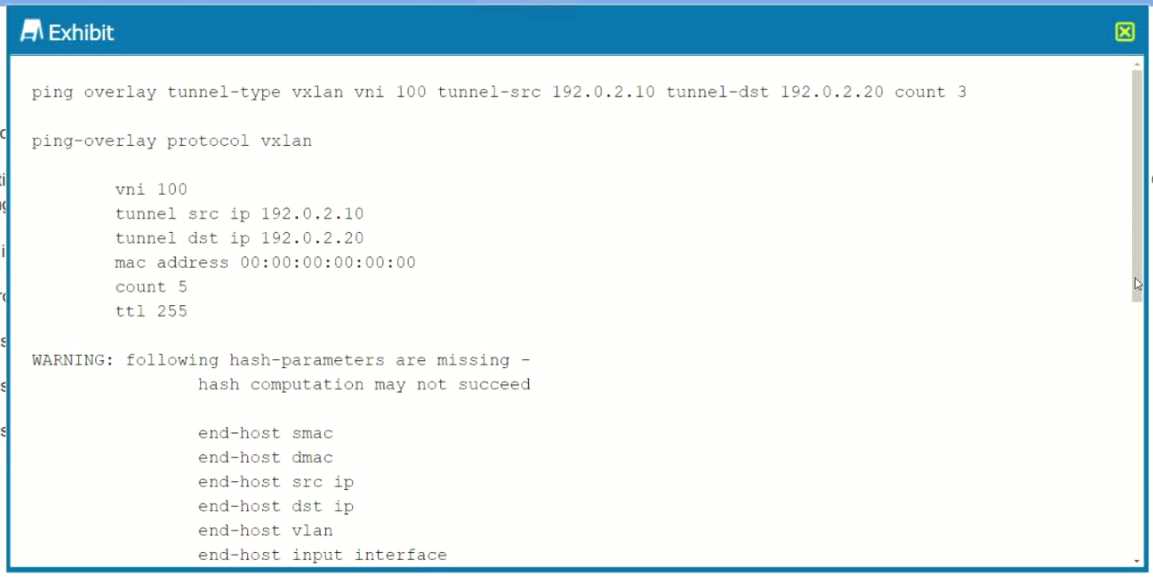
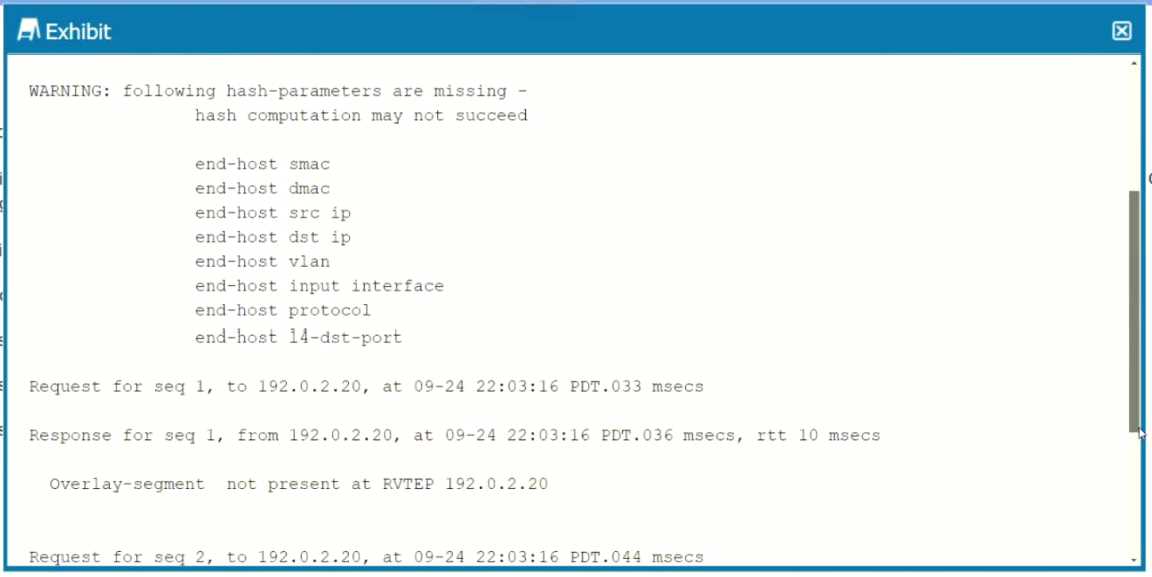
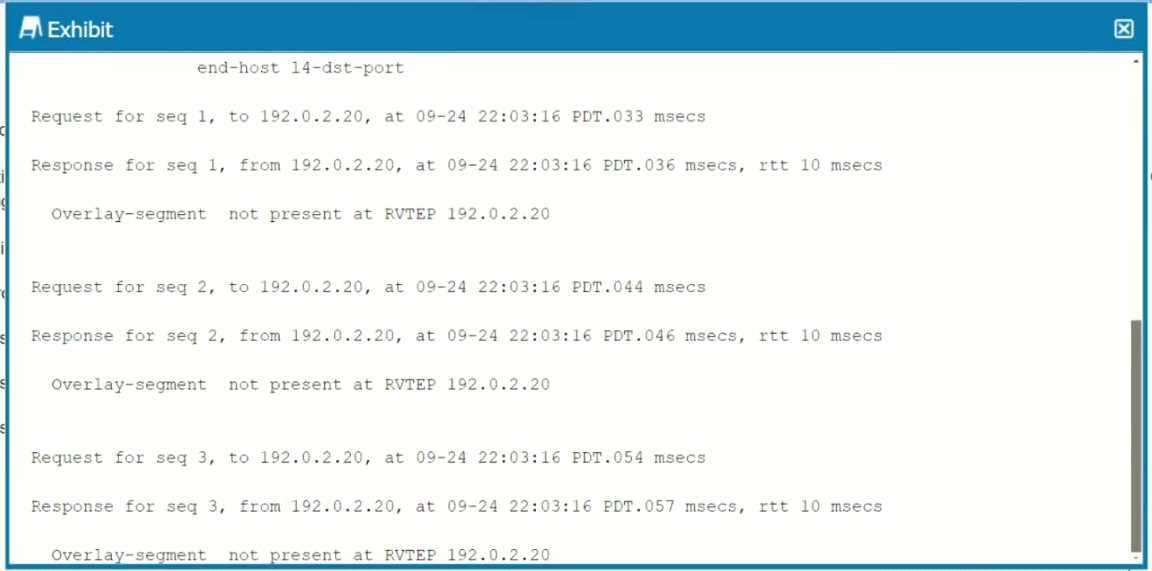
You are troubleshooting a connectivity issue across a VXLAN overlay network. In the exhibit, you are
using the ping overlay command from a local VTEP residing on a OFX 5120 to a remote VTEP residing
on a separate QFX5120.
What is the problem in this situation?
- A. The VXLAN controller is down.
- B. VXLAN VN1100 is not configured on the local VTEP
- C. VXLAN VN1100 is not configured on the remote VTEP.
- D. VXLAN VN1100 is not configured on both end points.
Answer:
C
Question 12
Which event triggers the generation of a EVPN type-4 route?
- A. When unknown unicast traffic is received on an interface.
- B. When known unicast traffic is received on an interface.
- C. When a new VNI is configured.
- D. When a new ESI is configured.
Answer:
D
Question 13
Exhibit.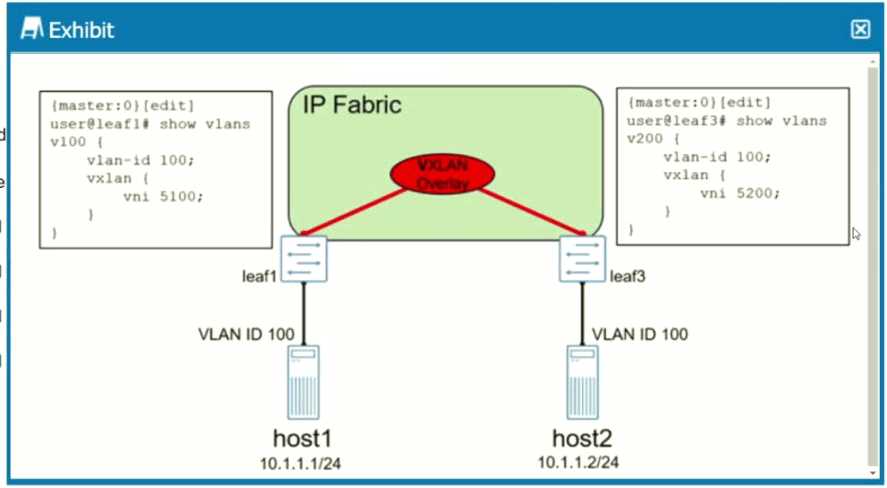
A VXLAN has been created between devices leaf1 and Ieaf3.
Referring to the exhibit, which statement is true?
- A. Traffic sent from host1 to host2 will be dropped on Ieaf3.
- B. Traffic sent from host1 to host2 will be tagged with VLAN ID 100 when exiting Ieaf3.
- C. Traffic sent from host1 to host2 will be tagged with VLAN ID 200 when exiting Ieaf3.
- D. Traffic sent from host1 to host2 will be dropped on leaf1.
Answer:
B
Question 14
Exhibit.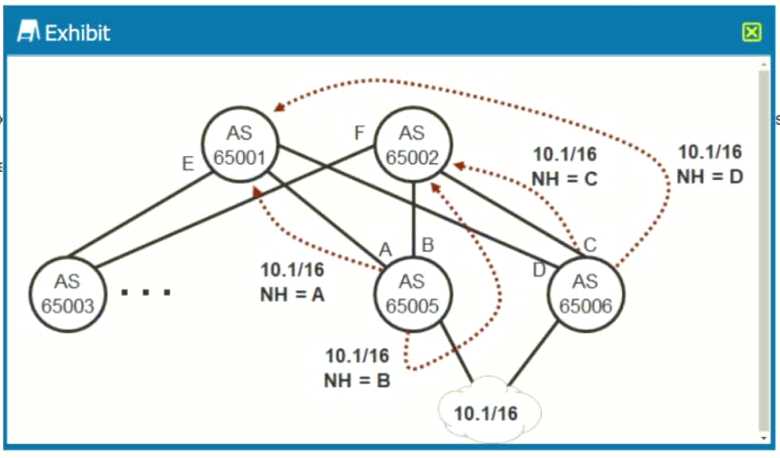
You choose the EBGP design shown in the exhibit as your IP fabric design. You must ensure that both
routes received by the spine nodes will be used for ECMP forwarding
Which BGP parameter would need to be added to the EBGP configuration of the spine nodes to
achieve this goal?
- A. multipath
- B. multihop
- C. add-path
- D. multipath multiple-as
Answer:
D
Question 15
Exhibit.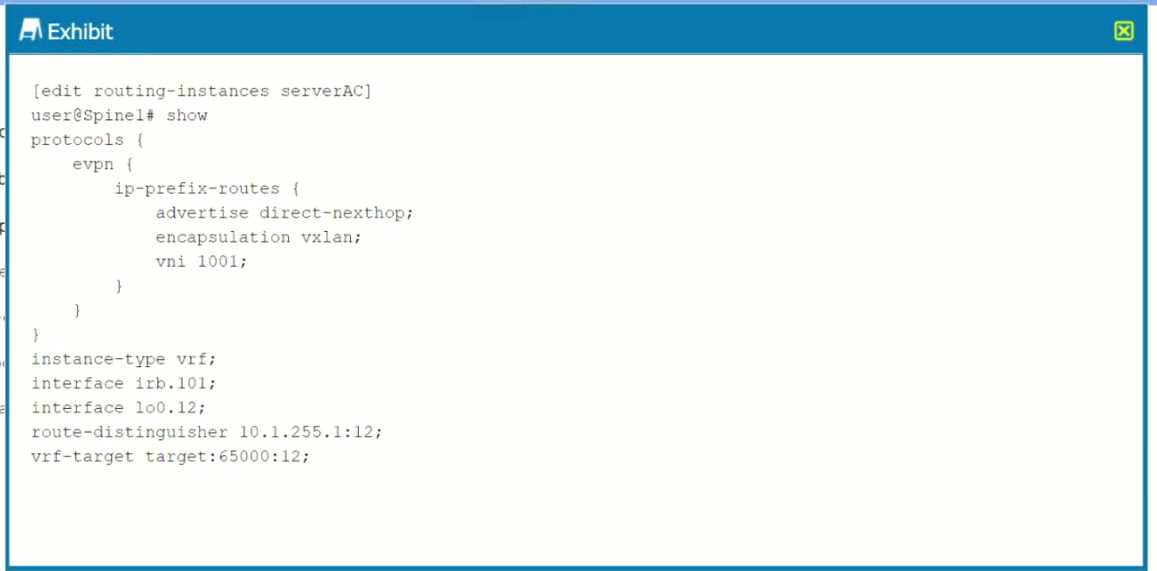
Referring to the exhibit, you must advertise the Io0.12 interface as a type-5 route.
Which configuration parameter would be used to accomplish this task?
- A. Configure auto-export under the routing instance.
- B. Configure a vrf-export policy to advertise the interface route under the routing instance.
- C. Configure an export policy to advertise the interface route under protocols evpn.
- D. Configure vrf-table-label under the routing instance.
Answer:
C